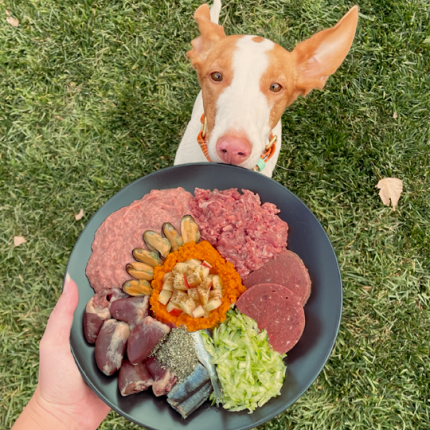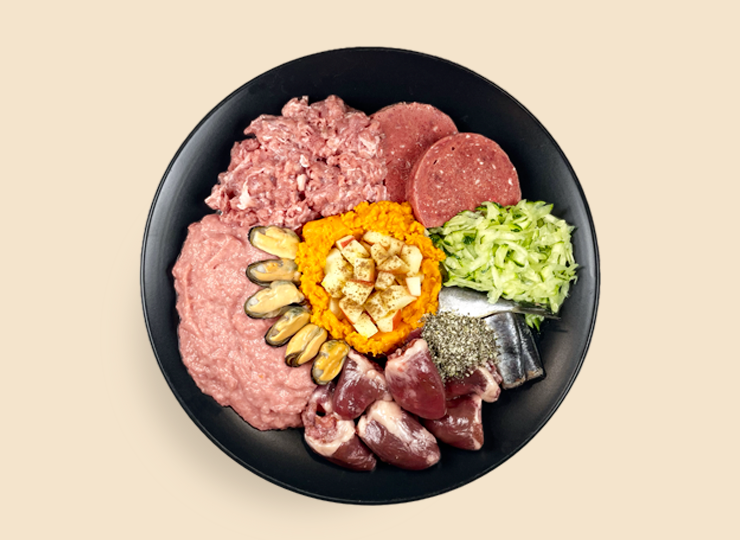DIY Raw Meal for Dogs: Harvest Bowl Recipe

DIY Raw Meal for Dogs: Harvest Bowl Recipe
For those who like to fully take the reins on their journey to Truly Raw, we’ve partnered with a certified canine nutritionist to create our DIY Raw Recipes series. These meals incorporate our DIY Parts products and other raw ingredients and are step-by-step recipes that you can follow to ensure you’re feeding your pet a complete and well-balanced raw meal.
A low-fat, harvest season themed plate for pet parents who prefer to spend time prepping DIY meals for their dog. Use up those fall apples and over-abundant garden zucchini. This recipe is balanced to AAFCO and NRC nutritional guidelines by our in-house certified canine nutritionist. This recipe is complete and balanced as it is written, and any ingredient changes or substitutions can affect the balance of the recipe.
Batch Recipe Ingredients
- Carnos Boneless Turkey – 1,550g
- Carnos Turkey Necks – 1,550g
- Carnos Turkey Hearts – 1,550g
- Carnos Turkey Organ Mix – 400g
- Carnos Beef Organ Mix – 400g
- Carnos Whole Sardines – 400g
- Zucchini, grated or chunked – 400g
- Apples, grated or chunked – 400g
- Sweet Potato, cooked – 1,200g
- Blue Mussels, cooked – 200g
- Pumpkin Seeds, ground – 20g
- Chia seeds, ground – 20g
- NOW Zinc Picolinate, 50mg – 2 pills
- NOW Iron Bisglycinate, 18mg – 5 pills
- NOW Kelp powder – 5 scoops
- NOW Vitamin E dry capsules – 3 pills
Recipe total yield = 286 ounces = 17.85 pounds
Recipe calories per ounce = 34.9 kcal/ounce
Recipe macronutrients = 13.3% protein, 5.5% fat, 4.5% carbohydrate (This recipe is low in fat. Therefore, it can be appropriate for most dogs who require a low fat diet.

Required Prep Supplies
- Meal containers
- Adequate freezer space
- Cutting board
- Knife
- Kitchen food scale
- Spice grinder
- Blender
How to calculate appropriate feeding amounts for your pet.
This is a very general guideline for calculating feeding amounts:
Adult dogs: 2% of bodyweight for inactive dogs, 2.5% of bodyweight for most average dogs, and 3-4% of bodyweight for highly active dogs.
Puppies: Puppies will typically start at 8-10% of bodyweight at 8-10 weeks of age. The percentage will slowly decrease as their weight/age increases. You want to feed enough that your puppy is not underweight, but not enough to make them chubby so take care to monitor their weight gain as they grow an adjust feeding amounts as necessary.
Example: A 45-pound healthy, average adult dog fed at 2.5% of their body weight should be fed 18 ounces of food per day.
*Every dog is an individual and their metabolism is unique to them. Feeding amounts should be adjusted as needed. If a dog is too thin and health issues have been ruled out, increase daily food. If a dog is too heavy and health conditions have been ruled out, decrease food within reason.
Meal Prep Instructions.

- Calculate how many days the recipe will last your dog. The batch can be doubled or tripled if desired. Set out the required amount of tupperware or bento boxes to hold meals. For example: if your dog eats approximately 1lb per day, the recipe as is would last about 18 days, and you would need 18 containers that are large enough to hold 1 pound of food. Larger dogs will need larger containers and feeding amounts, while smaller dogs will need smaller containers and amounts.
- Thaw meat ingredients. Cook sweet potato until soft and let cool, then mash. Skin can be removed or left on but some dogs will not eat the skin.
- Grind seeds for optimal digestion in a spice grinder. Place in a bowl and add the powder supplements (open any capsules). Mix seed powder and supplements thoroughly
- Measure out total amount of mashed sweet potato. Slowly sprinkle and mix in the seed/supplement powder thoroughly.
- Portion out each ingredient as evenly as possible into the meal containers
- Place 2-3 containers in the refrigerator and store the rest in the freezer. Remove 1 container from the freezer each day as 1 thawed container is used. Daily containers can be split into 2 meals per day if desired.
- An alternative prep method would be to use a grinder that can handle meat and small meaty bones or use our ground turkey necks. Then add all total ingredients to a large bussing bin or tub and mix together thoroughly, then portion as needed. *Do not grind in sardines due to thiaminase. When making a ground batch, add the sardines whole at meal time.*
Pro Tip: Use the total weight of ingredients rather than weighing each daily amount for each ingredient. In the example of prepping this recipe for 18 days, take the total grams of organ and divide into meal containers as equally as possible. No need to weigh ingredients individually for each day.
Nutritionist Tip: Green lipped mussels will not provide enough manganese to meet nutritional requirements. Blue or black mussels can often be found in the seafood section, such as the brand Panapesca. Blue or black mussels will simply be labeled “mussels” or “mussel meat” in contrast to green lipped mussels, which are labeled specifically as green lipped from New Zealand.